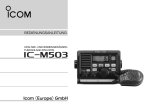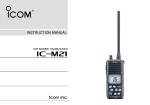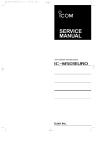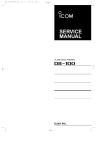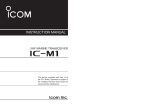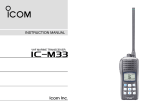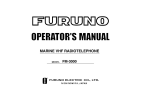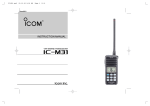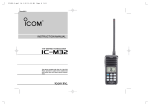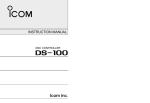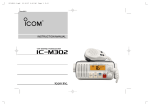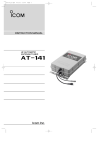Download Icom iM501EURO User's Manual
Transcript
0 IC-M501EURO_3.qxd 03.7.29 15:26 Page a INSTRUCTION MANUAL VHF MARINE TRANSCEIVER iM501EURO 0 IC-M501EURO_3.qxd 03.7.29 15:26 Page b IN CASE OF EMERGENCY If your vessel requires assistance, contact other vessels and the Coast Guard by sending a distress call on channel 16. USING CHANNEL 16 Or, transmit your distress call using digital selective calling on channel 70 (the optional DS-100 must be installed). USING DIGITAL SELECTIVE CALLING (ch 70) (DS-100 DSC CONTROLLER is required) DISTRESS CALL PROCEDURE 1. “MAYDAY MAYDAY MAYDAY.” 2. “THIS IS ...............” (name of vessel) 3. Your call sign or other indication of the vessel (AND 9-digit DSC ID if you have one). 4. “LOCATED AT ...............” (your position) 5. The nature of the distress and assistance required. 6. Any other information which might facilitate the rescue. DISTRESS CALL PROCEDURE 1. Push and hold [DISTRESS] on the DS-100 for 5 sec. until you hear 5 short beeps change to one long beep. 2. Wait for an acknowledgment from a coast station. • Channel 16 is automatically selected. 3. Push and hold [PTT], then transmit the appropriate information as at left. Versions of the IC-M501EURO which display the “CE” symbol on the serial number seal, comply with the essential requirements of the European Radio and Telecommunication Terminal Directive 1999/5/EC. ò This warning symbol indicates that this equipment operates in non-harmonised frequency bands and/or may be subject to licensing conditions in the country of use. Be sure to check that you have the correct version of this radio or the correct programming of this radio, to comply with national licensing requirement. i 0 IC-M501EURO_3.qxd 03.7.29 15:26 Page c INSTALLATION NOTES The installation of this equipment should be made in such a manner as to respect the EC recommended electromagnetic field exposure limits (1999/519/EC). The maximum RF power available from this device is 25 watts. The antenna should be installed as high as possible for maximum efficiency and that this installation height should be at least 5 meters above ground (or accessible) level. In the case where an antenna cannot be installed at a reasonable height, then the transmitter should neither be continuously operated for long periods if any person is within 5 meters of the antenna, nor operated at all if any person is touching the antenna. In all cases any possible risk depends on the transmitter being activated for long periods. (actual recommendation limits are specified as an average of 6 minutes) Normally the transmitter is not active for long periods of time. Some radio licenses will require that a timer circuit automatically cuts the transmitter after 1–2 minutes etc. Similarly some types of transmitter, SSB, CW, AM, etc. have a lower ‘average’ output power and the perceived risk is even lower. TABLE OF CONTENTS 1 OPERATING RULES .......................... 1 2 PANEL DESCRIPTION .................. 2 – 5 ■ Panel description ............................. 2 ■ Function display ............................... 4 ■ Microphone ...................................... 5 3 BASIC OPERATION .................... 6 – 10 ■ Channel selection ............................ 6 ■ Receiving and transmitting .............. 8 ■ Call channel programming ............... 9 ■ Channel names ................................ 9 ■ Optional voice scrambler operation .. 10 4 DUALWATCH/TRI-WATCH ............... 11 ■ Description ..................................... 11 ■ Operation ....................................... 11 5 SCAN OPERATIONS ................. 12 – 13 ■ Scan types ..................................... 12 ■ Setting tag channels ...................... 13 ■ Starting a scan ............................... 13 6 SET MODE ................................. 14 – 16 ■ Set mode programming ................. 14 ■ Set mode items .............................. 15 7 CONNECTIONS AND MAINTENANCE ......................... 17 – 22 ■ Unpacking ...................................... 17 ■ Antenna ......................................... 17 ■ Fuse replacement .......................... 17 ■ Cleaning ......................................... 17 ■ Connections ................................... 18 ■ Mounting the transceiver ............... 19 ■ Optional unit installation ................. 21 ■ Dimensions ..................................... 20 8 TROUBLESHOOTING ...................... 23 9 CHANNEL LIST ................................ 24 10 SPECIFICATIONS AND OPTIONS ... 25 ■ Specifications ................................. 25 ■ Options .......................................... 25 MB-75 TEMPLATE ii 0 IC-M501EURO_3.qxd 03.7.29 15:26 Page d IMPORTANT READ ALL INSTRUCTIONS carefully and completely SAVE THIS INSTRUCTION MANUAL — This in- before using the transceiver. struction manual contains important operating instructions for the IC-M501EURO. CAUTIONS RWARNING! NEVER connect the transceiver to an AC outlet. This may pose a fire hazard or result in an electric shock. DO NOT use or place the transceiver in areas with temperatures below –4°F (–20°C) or above +140°F (+60°C) or, in areas subject to direct sunlight, such as the dashboard. NEVER connect the transceiver to a power source of more than 16 V DC or using reverse polarity. This will ruin the transceiver. AVOID the use of chemical agents such as benzine or alcohol when cleaning, as they may damage the transceiver surfaces. NEVER cut the DC power cable between the DC plug and BE CAREFUL! The transceiver rear panel will become fuse holder. If an incorrect connection is made after cutting, the transceiver may be damaged. hot when operating continuously for long periods. NEVER place the transceiver where normal operation of the vehicle may be hindered or where it could cause bodily injury. KEEP the transceiver at least 3.3 ft (1 m) away from the ship’s navigation compass. iii Place the transceiver in a secure place to avoid inadvertent use by children. After exposure to water including fresh water, clean the transceiver thoroughly with fresh water to avoid corrosion. 0 IC-M501EURO_3.qxd 03.7.29 15:26 Page 1 OPERATING RULES ◊ PRIORITIES • Read all rules and regulations pertaining to priorities and keep an up-to-date copy handy. Safety and distress calls take priority over all others. • You must monitor channel 16 when you are not operating on another channel. • False or fraudulent distress signals are prohibited and punishable by law. ◊ PRIVACY • Information overheard but not intended for you cannot lawfully be used in any way. • Indecent or profane language is prohibited. 1 (2) OPERATOR’S LICENSE A Restricted Radiotelephone Operator Permit is the license most often held by small vessel radio operators when a radio is not required for safety purposes. The Restricted Radiotelephone Operator Permit must be posted or kept with the operator. Only a licensed radio operator may operate a transceiver. However, non-licensed individuals may talk over a transceiver if a licensed operator starts, supervises, ends the call and makes the necessary log entries. Keep a copy of the current government rules and regulations handy. ◊ RADIO LICENSES (1) SHIP STATION LICENSE You must have a current radio station license before using the transceiver. It is unlawful to operate a ship station which is not licensed. Inquire through your dealer or the appropriate government agency for a Ship-Radiotelephone license application. This government-issued license states the call sign which is your craft’s identification for radio purposes. 1 0 IC-M501EURO_3.qxd 2 03.7.29 15:26 Page 2 PANEL DESCRIPTION ■ Panel description !1 VHF MARINE !0 o i iM501EURO Function display 16 WATER RESISTANT Speaker SCAN DUAL POWER HI/LO VOL w q POWER SWITCH [POWER] Push to toggle the transceiver power ON and OFF. DIAL TAG q CALL DIMMER SQL e r t y u r TRANSMIT POWER SWITCH [HI/LO] ➥ Toggles high and low power when pushed. (p. 8) • Some channels are set to low power only. w VOLUME CONTROL [VOL] Adjusts the audio level. (p. 8) e SQUELCH CONTROL [SQL] Sets the squelch threshold level. (p. 8) 2 ➥ While pushing this switch, other switches perform secondary functions. 0 IC-M501EURO_3.qxd 03.7.29 15:26 Page 3 PANEL DESCRIPTION t CHANNEL SELECTOR [CHANNEL] Rotate [CHANNEL] to select the operating channels, set mode contents, etc. (p. 8) y DIMMER SWITCH [DIMMER] Push to select one of 8 backlighting (LCD and switches) levels. u CALL CHANNEL SWITCH [CALL] ➥ Push to select the call channel. (p. 6) ➥ Push for 3 sec. to enter call channel programming condition. (p. 9) ➥ While pushing [HI/LO], enters memory name programming condition. (p. 9) 2 !0 SCAN SWITCH [SCAN/TAG] (p. 13) ➥ Starts and stops normal or priority scan when tag channels are programmed. ➥ Push [SCAN/TAG] for 1 sec. to set the displayed channel as a tag (scanned) channel. ➥ While pushing [HI/LO], push for 3 sec. to clear all tag channels. !1 DUALWATCH/TRI-WATCH SWITCH [DUAL] (p. 11) ➥ Starts dualwatch or tri-watch when pushed. ➥ Stops dualwatch/tri-watch when either is activated. i CHANNEL 16 SWITCH [16] ➥ Selects channel 16 when pushed. (p. 6) ➥ Enters initial set mode when pushed while turning power ON. (p. 14) o DIAL SWITCH [DIAL] ➥ Exits from channel 16 or call channel when pushed. (p. 6) ➥ While pushing [HI/LO], selects channel group when pushed. (pgs. 6, 7) • The European version has International channels only and this function is not available. 3 0 IC-M501EURO_3.qxd 2 03.7.29 15:26 Page 4 PANEL DESCRIPTION ■ Function display o q w e r r CHANNEL NAME INDICATOR ➥ Channel comment appears if programmed. (p. 9) ➥ “Low Battery” appears when the battery voltage drops to approx. 10 V DC or below. ➥ “DUAL” appears during dualwatch; “TRI” appears during tri-watch. (p. 11) i BUSY INT 25W CALL TAG SC DUP CALLING u t y q BUSY/TRANSMIT INDICATOR (p. 8) ➥ “BUSY” appears when receiving a signal or when the squelch opens. ➥ “TX” appears while transmitting. w POWER INDICATOR (p. 8) ➥ “25W” appears when high power is selected. ➥ “1W” appears when low power is selected. e TAG CHANNEL INDICATOR (p. 13) Appears when a tag channel is selected. 4 t SCRAMBLER INDICATOR (p. 11) Appears when the optional voice scrambler is activated. y DUPLEX INDICATOR Appears when a duplex channel is selected. u CHANNEL NUMBER READOUT ➥ Indicates the selected operating channel number. “A” appears when a simplex channel is selected. (p. 6) ➥ In set mode, indicates the selected condition. (p. 14) i CHANNEL GROUP INDICATOR (p. 6) Indicates whether an International, U.S.A., Holland, DSC or ATIS channel is selected. • Available channel groups depend on version. o CALL CHANNEL INDICATOR (pgs. 6, 9) Appears when a call channel is selected. 0 IC-M501EURO_3.qxd 03.7.29 15:26 Page 5 PANEL DESCRIPTION 2 ■ Microphone q Speaker Microphone w e q PTT SWITCH [PTT] Push and hold to transmit; release to receive. (p. 8) Y]/[Z Z] w CHANNEL UP/DOWN SWITCHES [Y Push either switch to change the operating memory channel, set mode contents, etc. (p. 8) e TRANSMIT POWER SWITCH [HI/LO] ➥ Same as the [HI/LO] switch on the front panel. ➥ Toggles the [Y]/[Z] and [HI/LO] switch functions ON and OFF when pushed at power ON. 5 0 IC-M501EURO_3.qxd 3 03.7.29 15:26 Page 6 BASIC OPERATION ■ Channel selection ◊ Channel 16 Channel 16 is the distress and safety channel. It is used for establishing initial contact with another station and for emergency communications. Channel 16 is monitored during both dualwatch and tri-watch. While standing by, you must monitor channel 16. ➥ Push [16] to select channel 16. ➥ Push [DIAL] to return to the condition before selecting channel 16, or rotate [CHANNEL] to select operating channel. INT Push 16 25W TAG CALLING ◊ Call channel Each regular channel group has a separate leisure-use call channel. The call channel is monitored during tri-watch. The call channels can be programmed (p. 9) and are used to store your most often used channels in each channel group for quick recall. 6 ➥ Push [CALL] to select the call channel of the selected channel group. • “CALL” and call channel number appear. • Each channel group may have an independent call channel after changing a call channel. (U.K. version only) ➥ Push [DIAL] to return to the condition before selecting call channel, or rotate [CHANNEL] to select operating channel. Push CALL INT 25W CALL TAG CALLING ◊ International channels There are 55 International channels for the IC-M501EURO. q Push [DIAL] to select a regular channel. w Push [DIAL] while pushing [HI/LO] to change the channel group, if necessary. • “INT” appears when International channels are selected. e Rotate the channel selector to select a channel. • “DUP” appears for duplex channels. INT 25W TAG INTL DUP 0 IC-M501EURO_3.qxd 03.7.29 15:26 Page 7 BASIC OPERATION ◊ U.S.A. channels (U.K. version only) For the U.K. versions, there are 61 U.S.A. channels in addition to 56 International channels. 3 HOLLAND 1W DUP INTL q Push [DIAL] to select a regular channel. w To change the channel group, push [DIAL] while pushing [HI/LO]. • International and U.S.A. channels can be selected in sequence. e Rotate the channel selector to select a channel. • Channels are memorized separately for each channel group. USA 25W TAG CCG ◊ ATIS and DSC channels (FRG version only) For the FRG versions, there are 55 ATIS and 52 DSC channels in addition to 57 International channels. q Push [DIAL] to select a regular channel. w To change the channel group, push [DIAL] while pushing [HI/LO]. • International, ATIS and DSC channels can be selected in sequence. e Rotate the channel selector to select a channel. ◊ Holland channels (Holland version only) For the holland versions, there are 57 Holland channels in addition to 56 International channels. q Push [DIAL] to select a regular channel. w To change the channel group, push [DIAL] while pushing [HI/LO]. • Channels are memorized separately for each channel group. ATIS 25W TAG INTL DUP • International and Holland channels can be selected in sequence. e Rotate the channel selector to select a channel. • Channels are memorized separately for each channel group. 7 0 IC-M501EURO_3.qxd 3 03.7.29 15:26 Page 8 BASIC OPERATION ■ Receiving and transmitting CAUTION: Transmitting without an antenna may damage the transceiver. q Push [POWER] to turn power ON. w Set the audio and squelch levels. ➥ Rotate [SQL] fully counterclockwise in advance. ➥ Rotate [VOL] to adjust the audio output level. ➥ Rotate [SQL] clockwise until the noise disappears. e To change the channel group, push [DIAL] while pushing [HI/LO]. (p. 6) • The European version has International channels only. y Push and hold [PTT] to transmit, then speak into the microphone. • “TX” appears. • Channel 70 cannot be used for transmission (for GMDSS use). u Release [PTT] to receive. IMPORTANT: To maximize the readability of your transmitted signal, pause a few sec. after pushing [PTT], hold the microphone 10 to 15 cm (4 to 6 inches) from your mouth and speak at a normal voice level. q t r Rotate the channel selector or push [Y]/[Z] on the microphone to select the desired channel. • When receiving a signal, “BUSY” appears and audio is emitted from the speaker. • Further adjustment of [VOL] may be necessary at this point. • Use the optional voice scrambler function for privacy. (p. 10) t Push [HI/LO] to select the output power if necessary. • “25W” or “1W” appears when high or low power is selected, respectively. • Choose low power to conserve power, choose high power for longer distance communications. • Some channels are for low power only. 8 e VHF MARINE yu iM501EURO 16 WATER RESISTANT DUAL POWER VOL w SCAN DIAL TAG HI/LO CALL DIMMER SQL r r t 0 IC-M501EURO_3.qxd 03.7.29 15:26 Page 9 BASIC OPERATION 3 ■ Call channel programming ■ Channel names The call channel switch can be programmed to your most often-used channels in each channel group for quick recall. Memory channels can be tagged with alphanumeric names of up to 10 characters each. q While pushing [HI/LO], push [DIAL] one or more times to select the desired channel group (International, U.S.A., Holland, ATIS, DSC) to be programmed. w Push [CALL] for 3 sec. to enter the call channel programming condition. Capital letters, small letters, numerals, some symbols (! " # $ % & ' ( ) ✱ + , – . ⁄ ) and spaces can be used. • Channel number starts flashing. INT 25W CALL TAG CALLING e Rotate the channel selector to select the desired channel. 25W TAG INTL INT CALL DUP q Select the desired memory channel. • Cancel dual watch, tri-watch or scan in advance. w While pushing [HI/LO], push [CALL] to edit memory channel name. • A cursor appears and blinks. INT 25W TAG äLEASURE e Select the desired character by rotating the channel selector or by pushing [Y]/[Z] on the microphone. • Push [SCAN] or [DIAL] for cursor movement. r Push [CALL] to input and set the name. r Push [CALL] to program the displayed channel as the call channel. • Push [DIAL] to cancel. • The channel number stops flashing. • The cursor disappears. t Repeat steps q to r to program another memory channel names, if desired. 9 0 IC-M501EURO_3.qxd 3 03.7.29 15:26 Page 10 BASIC OPERATION ■ Optional voice scrambler operation ◊ Activating the scrambler ◊ Programming scrambler codes The optional voice scrambler provides private communications. In order to receive or send scrambled transmissions you must first activate the scrambler function. To activate the function, an optional UT-98 or UT-112 is necessary. See p. 16 for selecting the unit. Ask your dealer for details. There are 128 or 32 codes (0 to 127 or 1 to 32) available for programming. In order to understand one another, all transceivers in your group must have the same scramble code. q Select an operating channel except channel 16 and 70. w While pushing [HI/LO], push [DIMMER] to toggle an optional scrambler function ON or OFF. • “SC” appears. e To turn the scrambler function OFF, repeat step w. • “SC” disappears. This function may not be available depending on dealer setting. q Turn power OFF. w While pushing [16], turn power ON to enter set mode. e After the display appears, release [16]. r Push [16] one or more times to select the scrambler code item. • “Scrambler code” appears. t Rotate the channel selector to select the desired scrambler code. y Turn power OFF, then ON again to exit set mode. [Example]: Programming scrambler code 127. 16 + POWER Enter set mode Set mode Push one or more times. Beep Set mode 10 16 Set mode Scrambler code Scrambler code item Set mode Select code Scrambler code 0 IC-M501EURO_3.qxd 03.7.29 15:26 Page 11 DUAL WATCH/TRI-WATCH ■ Description ■ Operation Dualwatch monitors channel 16 while you are receiving another channel; tri-watch monitors channel 16 and the call channel while receiving another channel. q Select the desired operating channel. w Select dualwatch or tri-watch in set mode. (p. 15) e Push [DUAL] to start dualwatch or tri-watch. 4 • “DUAL” appears during dualwatch; “TRI” appears during tri-watch. • Beep tone sounds when a signal is received on channel 16. • Tri-watch becomes dualwatch when receiving a signal on the call channel. DUALWATCH/TRI-WATCH SIMULATION r To cancel dualwatch/tri-watch, push [DUAL] again. Call channel [Example]: Operating tri-watch on INT channel 25. INT 25W TAG TRI Dualwatch Tri-watch • If a signal is received on channel 16, dualwatch/tri-watch pauses on channel 16 until the signal disappears. • If a signal is received on the call channel during tri-watch, triwatch becomes dualwatch until the signal disappears. • To transmit on the selected channel during dualwatch/tri-watch, push and hold [PTT]. Tri-watch starts. DUP 16 BUSY INT 25W CALL TAG CALLING 16 Signal is received on call channel. BUSY 25W TAG CALLING Signal received on channel 16 takes priority. INT DUP 16 INT 25W TAG TRI DUP 16 Tri-watch resumes after the signal disappears. 11 0 IC-M501EURO_3.qxd 5 03.7.29 15:26 Page 12 SCAN OPERATIONS ■ Scan types Scanning is an efficient way to locate signals quickly over a wide frequency range. The transceiver has priority scan and normal scan. Set the tag channels (scanned channel) before scanning. Clear the tag channels which inconveniently stop scanning, such as digital communication use. Choose priority or normal scan in set mode. (p. 15) PRIORITY SCAN NORMAL SCAN CH 01 CH 06 CH 02 CH 16 CH 05 CH 01 CH 03 CH 04 Priority scan searches through all tag channels in sequence while monitoring channel 16. When a signal is detected on channel 16, scan pauses until the signal disappears; when a signal is detected on a channel other than channel 16, scan becomes dualwatch until the signal disappears. 12 CH 02 CH 06 CH 03 CH 05 CH 04 Normal scan, like priority scan, searches through all tag channels in sequence. However, unlike priority scan, channel 16 is not checked unless channel 16 is set as a tag channel. 0 IC-M501EURO_3.qxd 03.7.29 15:26 Page 13 SCAN OPERATION 5 ■ Setting tag channels ■ Starting a scan For more efficient scanning, add desired channels as tag channels or clear tag channels for unwanted channels. Channels set as non-tag channels will be skipped during scanning. Tag channels can be assigned to each channel group (International, U.S.A., Holland, DSC, ATIS) independently. Set scan type (priority or normal scan) and scan resume timer in advance using set mode. (p. 15) q While pushing [HI/LO], push [DIAL] one or more times to select the desired channel group, if desired. w Select the desired channel to set as a tag channel. e Push [SCAN/TAG] for 1 sec. to set the displayed channel as a tag channel. q Set tag channels as described at left. w While pushing [HI/LO], push [DIAL] one or more times to select the desired channel group, if desired. e Push [SCAN] to start priority or normal scan. • “Pri scan 16” or “Normal scan” appears in the function display. • When a signal is detected, scan pauses until the signal disappears or resumes after pausing 5 sec. according to set mode setting. (Channel 16 is still monitored during priority scan.) • Rotate the channel selector to check the scanning tag channels, to change the scanning direction or resume the scan manually. • “16” flashes and a beep tone sounds when a signal is received on channel 16 during priority scan. • “TAG” appears in the function display. r To cancel the tag channel setting, repeat e. • “TAG” disappears. • Clearing all tag channels in the selected channel group ➥ While pushing [HI/LO], push [DIAL] for 3 sec. to clear all tag channels in the channel group. r To stop the scan, push [SCAN]. • “Pri scan” or “Normal scan” disappears. [Example]: Starting a normal scan. INT 25W TAG INTL Push SCAN DUP TAG INT 25W TAG DUP Normal scan Scan starts. BUSY INT 25W TAG DUP Normal scan When a signal is received 13 0 IC-M501EURO_3.qxd 6 03.7.29 15:26 Page 14 SET MODE ■ Set mode programming q Turn power OFF. w While pushing [16], turn power ON to enter set mode. e After the display appears, release [16]. r Push [16] to select the desired item, if necessary. t Rotate the channel selector to select the desired condition of the item. y Turn power OFF, then ON again to exit set mode. Set mode is used to change the conditions of the transceiver’s functions: beep tone function, scan mode (normal/priority), scan resume timer, dual/tri watch, LCD contrast, scramble code, scrambler unit, internal speaker and ATIS code. Available functions may differ depending on versions. • SET MODE CONSTRUCTION Beep tone Scan mode Scan resume timer Dual/tri watch Beep Scan mode Scan timer DUAL/TRI ATIS check ATIS check 14 Push 16 Scrambler unit Scrambler code Internal speaker LCD contrast Scrambler Scrambler code Internal speaker LCD contrast 0 IC-M501EURO_3.qxd 03.7.29 15:26 Page 15 SET MODE ■ Set mode items ◊ Scan resume timer ◊ Beep tone You can select silent operation by turning beep tones OFF or you can have confirmation beeps sound at the push of a switch by turning beep tones ON. The scan resume timer can be selected as a pause (OFF) or timer scan (ON). When OFF is selected, the scan pauses until the signal disappears. When ON is selected, the scan pauses 5 sec. and resumes even if a signal is being received on channels except for channel 16. Set mode Set mode Beep Scan timer Beep tone ON (default) 6 Beep tone OFF Scan timer ON (default) Scan timer OFF ◊ Scan mode ◊ Dual/tri watch The transceiver has 2 scan modes: normal scan and priority scan. Normal scan searches all tag channels in the selected channel group. Priority scan searches all tag channels in sequence while monitoring channel 16. This item sets the [DUAL] switch function as dual watch or triwatch. See the section ‘Dual watch/Tri-watch’ for details. Set mode Set mode Scan mode DUAL/TRI Priority scan (default) Normal scan Dual watch (default) Tri-watch 15 0 IC-M501EURO_3.qxd 6 03.7.29 15:26 Page 16 SET MODE ◊ LCD contrast This item adjusts the contrast of the LCD in 8 steps. Scrambler code Set mode LCD contrast Scrambler code 0 (UT-98 default) LCD contrast 4 (default) Scrambler code 127 ◊ Scrambler unit When an optional scrambler unit is connected, the scrambler unit can be selected in set mode depending on dealer setting. ◊ Internal speaker When an optional external speaker is connected, the speakers on the transceiver and microphone can be muted. Set mode Scrambler Set mode Internal speaker Internal speaker ON (default) Set mode UT-98 scrambler unit Internal speaker OFF UT-112 scrambler unit ◊ ATIS check The ATIS ID code can be checked in set mode. ◊ Scrambler code When an optional scrambler unit is connected, the scrambler code can be set depending on dealer setting. When the UT-98 or UT-112 is installed, 128 or 32 codes (0 to 127 or 1 to 32) can be selected, respectively. 16 Set mode ATIS check 0123456789 ATIS code 0 IC-M501EURO_3.qxd 03.7.29 15:26 Page 17 CONNECTIONS AND MAINTENANCE 7 ■ Unpacking ■ Antenna The following accessories are supplied: Qty. q Mounting bracket ............................................................ 1 w Microphone hanger (OPC-562) ...................................... 1 e Mic hanger screws (3.5 × 30) ......................................... 2 r Mounting screws (5 × 20) ............................................... 2 t Flat washers (M5) ........................................................... 2 y Spring washers (M5) ...................................................... 2 u Mounting bracket knobs ................................................. 2 i DC power cable (OPC-947) ........................................... 1 A key element in the performance of any communication system is an antenna. Ask your dealer about antennas and the best places to mount them. q ■ Fuse replacement Two fuses are installed in the supplied DC power cable. If a fuse blows or the transceiver stops functioning, track down the source of the problem, if possible, and replace the damaged fuse with a new, rated one. w e i u Fuse rating: 10 A r ■ Cleaning t If the transceiver becomes dusty or dirty, wipe it clean with a soft, dry cloth. y AVOID the use of solvents such as benzene or alcohol, as they may damage transceiver surfaces. 17 0 IC-M501EURO_3.qxd 7 03.7.29 15:26 Page 18 CONNECTIONS AND MAINTENANCE ■ Connections q w EXTENSION JACK Connects to optional DS-100 DSC CONTROLLER. r e w q DC POWER CONNECTOR Connects the supplied DC power cable from this connector to an external 12 V DC power source. CAUTION: After connecting the DC power cable and external speaker jack, cover the connector and jack as shown below to avoid water seeping into the transceiver. 18 e ANTENNA CONNECTOR Connects a marine VHF antenna with a PL-259 connector to the transceiver. CAUTION: Transmitting without an antenna may damage the transceiver. r EXTERNAL SPEAKER JACK Connects to an external speaker. See ‘Options’ on p. 25 for available external speakers. MICROPHONE HANGER Rest the supplied microphone on the hanger when not in use. 0 IC-M501EURO_3.qxd 03.7.29 15:26 Page 19 CONNECTIONS AND MAINTENANCE ■ Mounting the transceiver 7 • OVERHEAD MOUNTING ◊ Using the supplied mounting bracket The universal mounting bracket supplied with your transceiver allows overhead or dashboard mounting. • Mount the transceiver securely with the 2 supplied screws (M5 × 20) to a surface which is more than 10 mm thick and can support more than 5 kg. • Mount the transceiver so that the face of the transceiver is at 90° to your line of sight when operating it. CAUTION: KEEP the transceiver and microphone at least 1 meter away from your vessel’s magnetic navigation compass. • MOUNTING ON DASHBOARD NOTE: Check the installation angle; the function display may not be easy-to-read at some angles. 19 0 IC-M501EURO_3.qxd 7 03.7.29 15:26 Page 20 CONNECTIONS AND MAINTENANCE ◊ Using the optional mounting bracket An optional MB-75 FLUSH MOUNT is available for mounting the transceiver to a flat surface such as an instrument panel. r Attach the clamps on either side of the transceiver. • Make sure that the clamps align parallel to the transceiver body. CAUTION: KEEP the transceiver and microphone at least 1 meter away from your vessel’s magnetic navigation compass. q Using the template on the last page, carefully cut a hole into the instrument panel (or wherever you plan to mount the controller). w Slide the transceiver through the hole as shown below. t Tighten the end bolts on the clamps (rotate clockwise) so that the clamps press firmly against the inside of the instrument control panel. y Tighten the locking nuts (rotate counterclockwise) so that the transceiver is securely mounted in position as below. u Connect the antenna and control cable, then return the instrument control panel to its original place. e Attach the 2 supplied bolts (M5 × 8 mm) on either side of the IC-M501EURO. 20 0 IC-M501EURO_3.qxd 03.7.29 15:26 Page 21 CONNECTIONS AND MAINTENANCE 7 ■ Optional unit installation CAUTION: DISCONNECT the DC power cable from the transceiver before performing any work on the transceiver. Otherwise, there is danger of electric shock and/or equipment damage. w Remove the 4 screws from the shielding plate, then lift up the shielding plate. e Plug an optional unit to J6 on the MAIN unit as shown below. ◊ Opening the transceiver case Follow the case opening procedure shown here when you want to install an optional unit, etc. q Remove the 6 screws as shown below and open the transceiver. Optional unit r Return the shielding plate and assemble the units to their original positions. 21 0 IC-M501EURO_3.qxd 7 03.7.29 15:26 Page 22 CONNECTIONS AND MAINTENANCE ■ Dimensions 110.0 (4 11⁄32˝) 109.4 (4 5⁄16˝) 145.0 (5 23⁄32˝) 165.0 (6 1⁄2˝) 22 31.4 (1 1⁄4˝) 53.0 (2 3⁄32˝) Unit: mm (inch) 0 IC-M501EURO_3.qxd 03.7.29 15:26 Page 23 TROUBLESHOOTING PROBLEM POSSIBLE CAUSE SOLUTION 8 REF. No power comes ON. • Bad connection to the power supply. • Check the connection to the transceiver. p. 18 No sound comes from the speaker. • Squelch level is too deep. • Volume level is too low. • Speaker has been exposed to water. • Set squelch to the threshold point. • Set [VOL] to a suitable level. • Drain water from the speaker. p. 8 p. 8 — Transmitting is impossi- • Some channels are for low power or reble, or high power can- ceive only. not be selected. • The output power is set to low. • Change channels. pgs. 6, 24 p. 8 Scan does not start. • “TAG” channel is not programmed. • Set the desired channels as “TAG” channels. p. 13 No beep sounds. • Beep tone is turned OFF. • Turn the beep tone ON in SET mode. p. 15 Receive signal cannot be understood. • Optional voice scrambler is turned OFF. • Scramble code is not set correctly. • Turn the optional voice scrambler ON. • Reset the scramble code. p. 10 p. 16 • Push [HI/LO] to select high power. 23 0 IC-M501EURO_3.qxd 9 03.7.29 15:26 Page 24 CHANNEL LIST • International channels CH Frequency (MHz) Transmit Receive CH Frequency (MHz) Transmit Receive CH Frequency (MHz) Transmit Receive CH Frequency (MHz) Transmit Receive CH Frequency (MHz) Transmit Receive CH Frequency (MHz) Transmit Receive 01 156.050 160.650 11 156.550 156.550 21 157.050 161.650 62 156.125 160.725 72 156.625 156.625 84 157.225 161.825 02 156.100 160.700 12 156.600 156.600 22 157.100 161.700 63 156.175 160.775 73 156.675 156.675 85 157.275 161.875 03 156.150 160.750 13 156.650 156.650 23 157.150 161.750 64 156.225 160.825 74 156.725 156.725 86 157.325 161.925 04 156.200 160.800 14 156.700 156.700 24 157.200 161.800 65 156.275 160.875 77 156.875 156.875 87 157.375 161.975 05 156.250 160.850 15† 156.750 156.750 25 157.250 161.850 66 156.325 160.925 78 156.925 161.525 88 157.425 162.025 06 156.300 156.300 16 156.800 156.800 26 157.300 161.900 67 156.375 156.375 79 156.975 161.575 07 156.350 160.950 17† 156.850 156.850 27 157.350 161.950 68 156.425 156.425 80 157.025 161.625 08 156.400 156.400 18 156.900 161.500 28 157.400 162.000 69 156.475 156.475 81 157.075 161.675 09 156.450 156.450 19 156.950 161.550 60 156.025 160.625 70‡ 156.525 156.525 82 157.125 161.725 10 156.500 156.500 20 157.000 161.600 61 156.075 160.675 71 156.575 156.575 83 157.175 161.775 • U.S.A. channels (for U.K. version only) CH CH Frequency (MHz) Transmit Receive CH Frequency (MHz) Transmit Receive CH Frequency (MHz) Transmit Receive CH Frequency (MHz) Transmit Receive CH Frequency (MHz) Transmit Receive 01A 156.050 156.050 11 156.550 156.550 20A 157.000 157.000 61A 156.075 156.075 71 156.575 156.575 83A 157.175 157.175 02A 156.100 156.100 12 156.600 156.600 21A 157.050 157.050 62A 156.125 156.125 72 156.625 156.625 84 157.225 161.825 03A 156.150 156.150 13† 156.650 156.650 22A 157.100 157.100 63A 156.175 156.175 73 156.675 156.675 85 157.275 161.875 04A 156.200 156.200 14 156.700 156.700 23A 157.150 157.150 64A 156.225 156.225 74 156.725 156.725 86 157.325 161.925 05A 156.250 156.250 15‡ 156.750 156.750 24 157.200 161.800 65A 156.275 156.275 77 156.875 156.875 86A 157.325 157.325 156.300 156.300 16 156.800 156.800 25 157.250 161.850 66A 156.325 156.325 78A 156.925 156.925 87 157.375 161.975 07A 156.350 156.350 17† 156.850 156.850 26 157.300 161.900 67† 156.375 156.375 79A 156.975 156.975 88 157.425 162.025 88A 157.425 157.425 06 08 156.400 156.400 18A 156.900 156.900 27 157.350 161.950 68 156.425 156.425 80A 157.025 157.025 09 156.450 156.450 19A 156.950 156.950 28 157.400 162.000 69 156.475 156.475 81A 157.075 157.075 10 156.500 156.500 20 157.000 161.600 60A 156.025 156.025 70‡ 156.525 156.525 82A 157.125 157.125 † Low 24 Frequency (MHz) Transmit Receive power only for U.K. version. ‡ Receive only. 0 IC-M501EURO_3.qxd 03.7.29 15:26 Page 25 SPECIFICATIONS AND OPTIONS 10 ■ Specifications ■ Options • GENERAL • DS-100 DSC CONTROLLER When the DS-100 is installed, the transceiver conforms to DSC class D for marine digital communications. • Frequency coverage Transmit Receive • Mode • Channel spacing • Current drain (at 13.8 V) • Power supply requirement • Frequency stability • Dimensions (Projection not included) • Weight : 156.025–157.425 MHz 156.025–162.025 MHz : FM (16K0G3E) : 25 kHz : TX high 6.0 A max. Max. audio 1.2 A max. : 13.8 V DC : ±10 ppm (–20°C to +60°C; –4°F to +140°F) : 165(W) × 110(H) × 109.4(D) mm : 1130 g • TRANSMITTER • Output power • Modulation system • Max. frequency deviation • Spurious emissions : 25 W and 1 W : Variable reactance phase modulation : ±5.0 kHz : Less than 0.25 µW • MB-75 FLUSH MOUNT For mounting the transceiver to a panel. • SP-5 EXTERNAL SPEAKER A large, external speaker for superior audio output. • SP-10 EXTERNAL SPEAKER A compact, external speaker. Features easy installation. • UT-98 VOICE SCRAMBLER UNIT • UT-112 VOICE SCRAMBLER UNIT Ensures private communications. 128 or 32 codes are available. Not available in some countries. • RECEIVER • Receive system : Double conversion superheterodyne • Sensitivity (12 dB SINAD) : Less than 0.32 µV (typical) • Squelch sensitivity : Less than 0.32 µV • Intermodulation rejection ratio : More than 68 dB • Spurious response rejection ratio: More than 70 dB • Adjacent channel selectivity : More than 70 dB • Audio output power : 3.5 W at 10% distortion with a 4 Ω load All stated specifications are subject to change without notice or obligation. 25 0 IC-M501EURO_3.qxd 03.7.29 15:26 Page 26 Blank page 0 IC-M501EURO_3.qxd 03.7.29 15:26 Page 27 MB-75 TEMPLATE 149 (57/8˝) Cut here 92 (35/8˝) 4–R11 Unit: mm (inch) 0 IC-M501EURO_3.qxd 03.7.29 15:26 Page 28 Blank page 0 IC-M501EURO_3.qxd 03.7.29 15:26 Page 29 DECLARATION OF CONFORMITY 0560 We Icom Inc. Japan 1-1-32 Kamiminami, Hirano-ku, Osaka 547-0003 Japan Declare on our sole responsability that this equipment complies the essential requirements of the Radio and Telecommunications Terminal Equipment Directive, 1999/5/EC, and that any applicable Essential Test Suite measurements have been performed. Kind of equipment: VHF MARINE TRANSCEIVER Type-designation: iC-m501euro Version (where applicable): This compliances is based on conformity with the following harmonised standards, specifications or documents: i) EN301 025-2 v1.1.1 08/2000 ii) prEN300 162-2 v1.1.1 07/2000 iii) EN60945 1997 iv) EN60950 1992 v) ETS300 698 1997 Annex B vi) prEN300 698-2 v1.1.1 03/2000 Düsseldorf 11th Oct. 2000 Place and date of issue Icom (Europe) GmbH Himmelgeister straße 100 D-40225 Düsseldorf Authorized representative name Icom (Europe) GmbH T. Aoki General Manager Signature 0 IC-M501EURO_3.qxd 03.7.29 15:26 Page Z Count on us! < Intended Country of Use > GER AUT GBR IRL FRA A-5661H-1EU-e Printed in Japan © 2000 Icom Inc. NED BEL LUX ESP POR ITA GRE SWE DEN FIN 1-1-32 Kamiminami, Hirano-ku, Osaka 547-0003 Japan


































